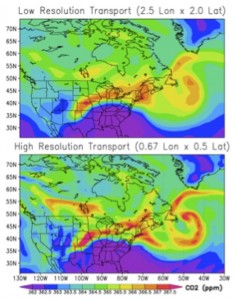NASA OCO (Kawa)
MODELING THE GLOBAL ATMOSPHERIC CARBON CYCLE IN PREPARATION FOR OCO DATA
NASA 2008-2010
We propose to build on process-level understanding and global simulation capability developed in previous work to synthesize an improved modeling/data analysis procedure capable of incorporating OCO and other relevant data to more precisely characterize the atmospheric carbon budget. Recent progress in simulating atmospheric CO2 using models driven by analyzed meteorology from the NASA GEOS-4 data assimilation demonstrates considerable skill in reproducing observed variability on time scales from hourly to interannual. The ability to meaningfully compare simulated CO2 with real-time, local observations allows us to better exploit the information content of more extensive and intensive observations including those from the Orbiting Carbon Observatory (OCO) scheduled for launch in 2008. These observations comprise a wealth of information on the distribution and sensitivity of carbon cycle processes over a wide range of time and spatial scales. Better understanding of these processes and their representation in numerical models is key to resolving long-standing uncertainties in the CO2 budget and confidently projecting interactions of the carbon cycle with climate change. Our goal is to utilize OCO and other data constraints to reduce uncertainty in the atmospheric carbon budget and its dependence on changing weather and climate.
Specific tasks include:1) Continue to evaluate and quantify uncertainty in atmospheric transport and its impact on top-down inference of carbon source/sink distributions including evaluation of the transport characteristics of GEOS-5. 2) Integrate, evaluate, and refine terrestrial biogeochemical process models constrained by global satellite observations including simulation of COS as an indicator of vegetation processes. 3) Prepare for OCO by testing inverse models and pseudo-data consistent with expected OCO instrument sampling, and, when available, use OCO data to infer CO2 sources and sinks. The results will be improved models and process understanding directly relevant to the objectives of NASA Earth Science and Carbon Cycle Research.


